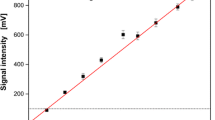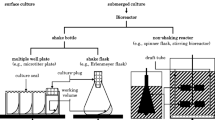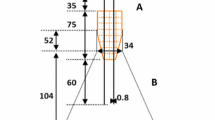Abstract
On-line measurement of dissolved O2 in shake-flasks was realized via immobilized sensor spots containing a fluorophore with an O2-dependent luminescent decay time. An unaffected sensor signal during 80 autoclaving cycles suggests multi-usage of sensor equipped shake-flasks. The sensor had a response time of 6 s. Quantification of gas-liquid mass transfer revealed maximum kLa values of 150 h−1, from which maximum O2 transfer capacity of 33 mM h−1 was calculated. Liquid volume and shaking frequency have a strong influence on kLa. Exemplified by cultivations of Corynebacterium glutamicum the importance of shaking rate for O2 supply of bacterial cultures is shown. Sampling of microbial cultures with intermittent shaking of a few minutes can cause O2 limitation. Based on the results of this work a simple and straightforward tool is now available for accurate O2 sensing in shake-flasks, which are widely used in microbial cultivations.
Similar content being viewed by others
References
Bourne JR, Zurita E, Heinzle E (1992) Bioreactor scale-up for the oxygen-sensitive culture Bacillus subtilis: the influence of stirrer shaft geometry. Biotechnol. Prog. 8: 580–582.
Büchs J (2000) Introduction to advantages and problems of shaken cultures. Biochem. Eng. J. 7: 91–98.
Duetz WA, Ruedi L, Hermann R, O'Connor K, Büchs J, Witholt B (2000) Methods for intense aeration, growth, storage, and replication of bacterial strains in microtiter plates. Appl. Environ. Microbiol. 66: 2641–2646.
Hewitt CJ, Nebe-Von Caron G, Axelsson B, McFarlane CM, Nienow AW (2000) Studies related to the scale-up of high-cell-density E. coli fed-batch fermentations using multiparameter flow cytometry: effect of a changing microenvironment with respect to glucose and dissolved oxygen concentration. Biotechnol. Bioeng. 70: 381–390.
John GT, Klimant I, Wittmann C, Heinzle E (2002) Integrated optical sensing of dissolved oxygen in microtiter plates – A novel tool for microbial cultivation. Biotechnol. Bioeng., in press.
Klimant I, Wolfbeis OS (1995) Oxygen-sensitive luminescent materials based on silicone-soluble ruthenium diimine complexes. Anal. Chem. 67: 3160–3166.
Maier U, Büchs J (2001) Characterization of the gas-liquid mass transfer in shaking bioreactors. Biochem. Eng. J. 7: 99–106.
Nakano MM, Hulett FM (1997) Adaptation of Bacillus subtilis to oxygen limitation. FEMS Microbiol. Lett. 157: 1–7.
Schumpe A, Quicker G, Deckwer WD (1982) Gas solubilities in microbial culture media. Adv. Biochem. Eng. 24: 1–38.
Tolosa L, Kostov Y, Harms P, Rao G (2002) Non-invasive measurement of dissolved oxygen in shake-flasks. Biotechnol. Bioeng. 80: 594–597.
Tunac JB (1989) High-aeration capacity shake-flask system. J. Ferm. Eng. 68: 157–159.
Wittmann C, Heinzle E (2002) Genealogy profiling through strain improvement using metabolic network analysis – Metabolic flux genealogy of several generations of lysine producing corynebacteria. Appl. Environ. Microbiol. 68: 5843–5859.
Author information
Authors and Affiliations
Corresponding author
Rights and permissions
About this article
Cite this article
Wittmann, C., Kim, H.M., John, G. et al. Characterization and application of an optical sensor for quantification of dissolved O2 in shake-flasks. Biotechnology Letters 25, 377–380 (2003). https://doi.org/10.1023/A:1022402212537
Issue Date:
DOI: https://doi.org/10.1023/A:1022402212537




